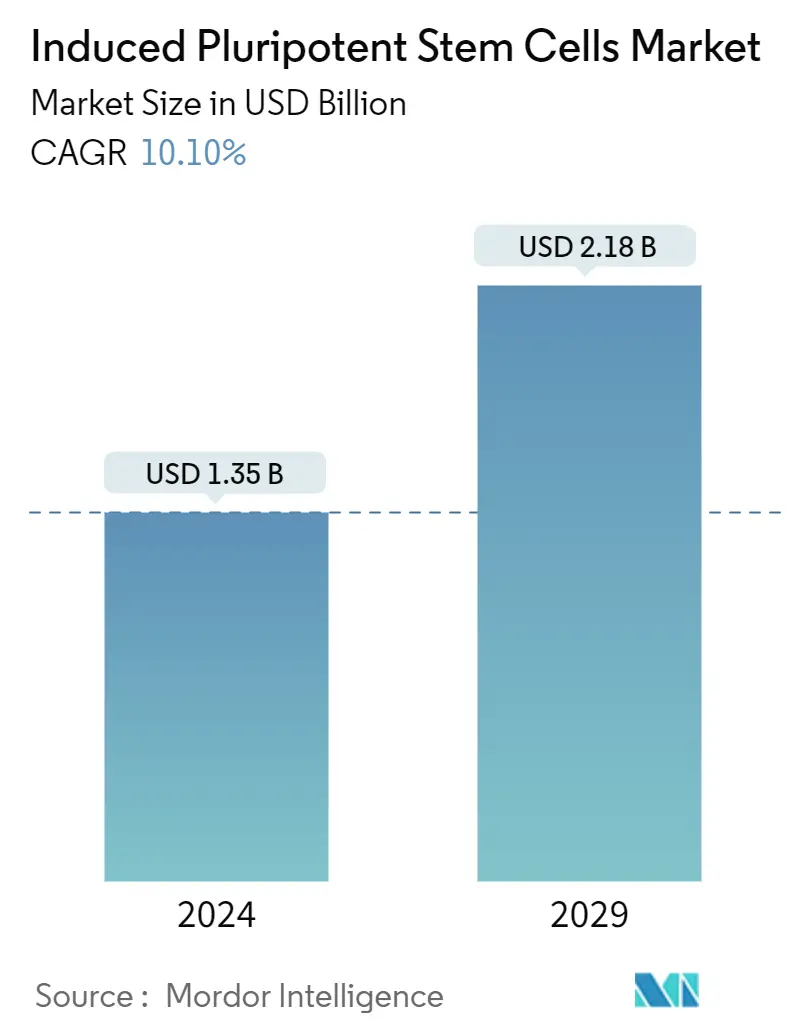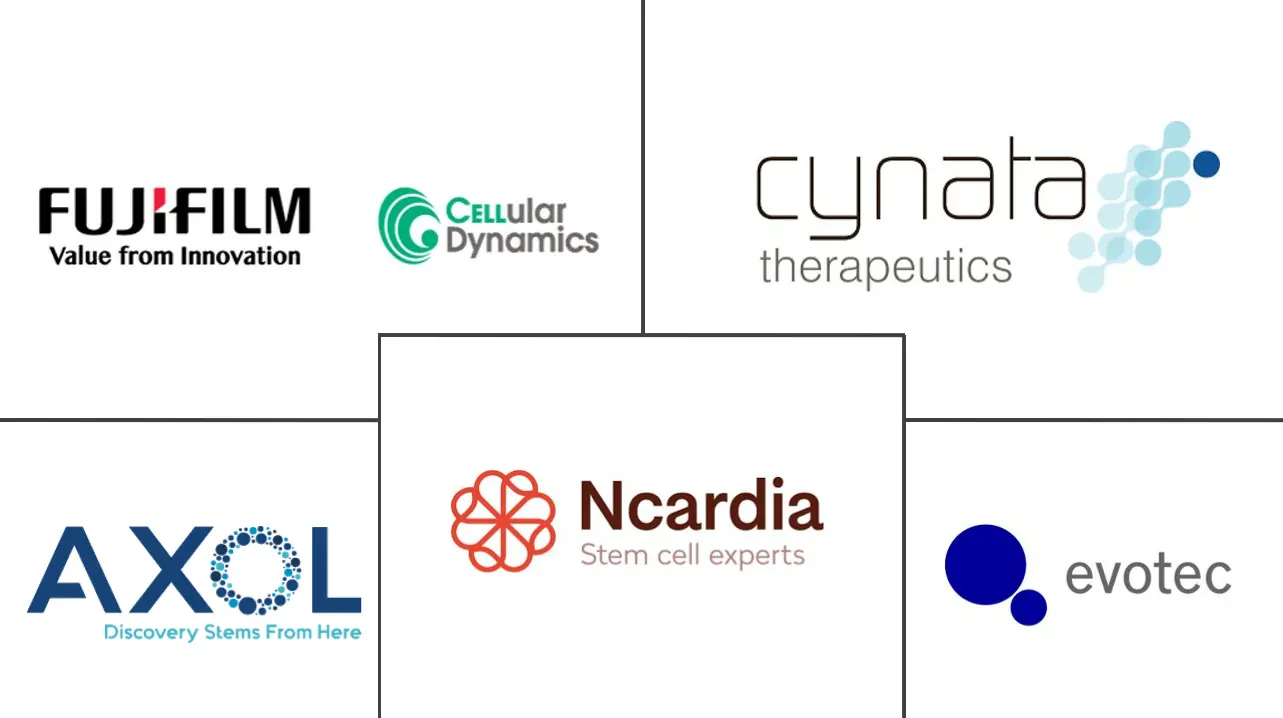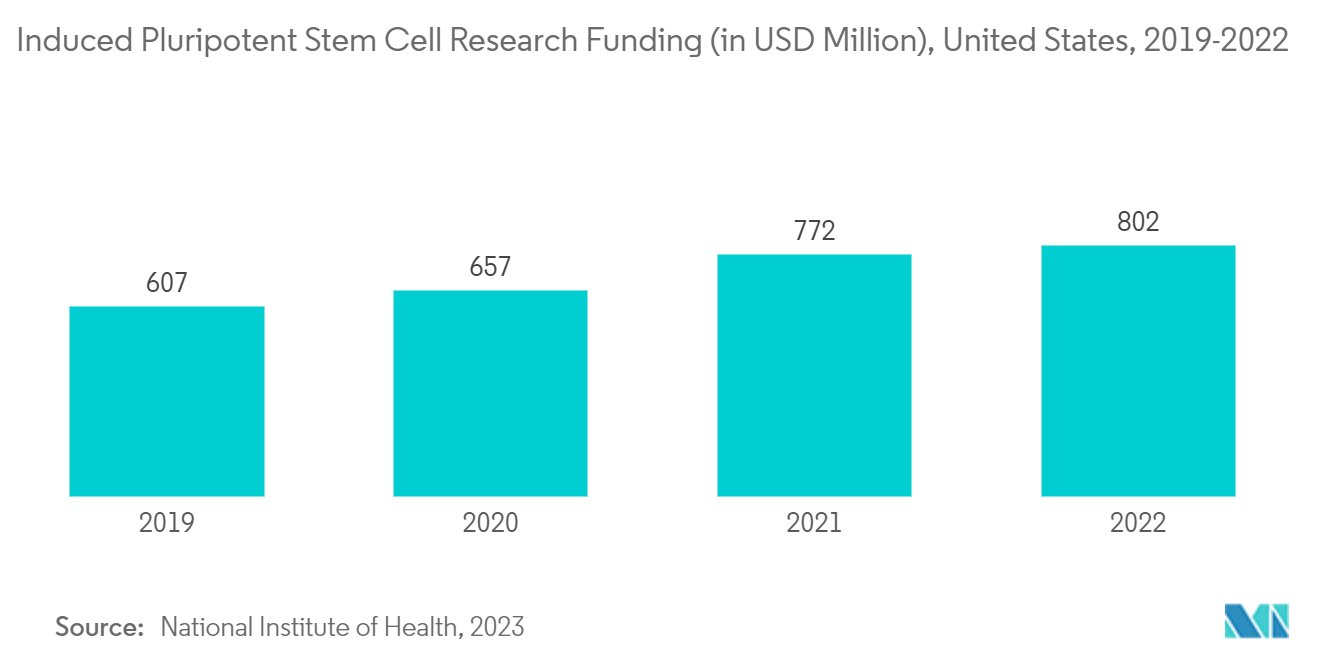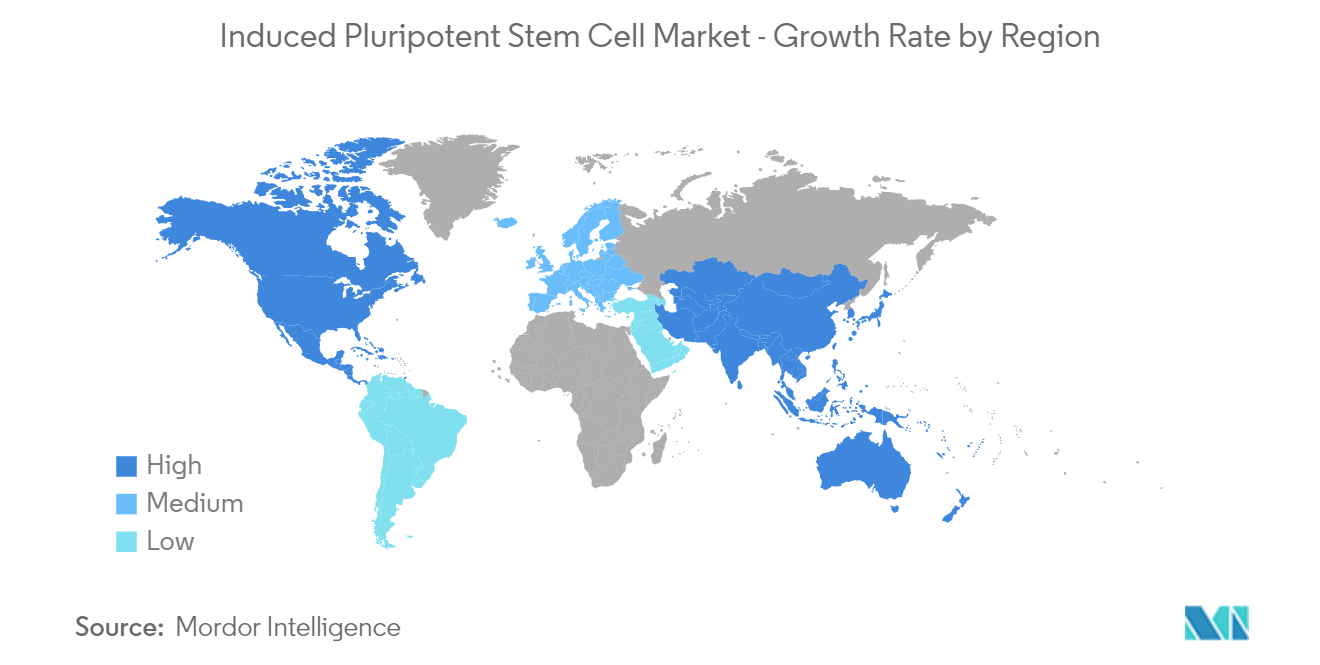Induced Pluripotent Stem Cells (iPSCs) Market Size

| Study Period | 2019 - 2029 |
| Market Size (2024) | USD 1.35 Billion |
| Market Size (2029) | USD 2.18 Billion |
| CAGR (2024 - 2029) | 10.10 % |
| Fastest Growing Market | Asia-Pacific |
| Largest Market | North America |
| Market Concentration | Medium |
Major Players
*Disclaimer: Major Players sorted in no particular order |
Induced Pluripotent Stem Cells (iPSCs) Market Analysis
The Induced Pluripotent Stem Cells Market size is estimated at USD 1.35 billion in 2024, and is expected to reach USD 2.18 billion by 2029, growing at a CAGR of 10.10% during the forecast period (2024-2029).
The COVID-19 pandemic has imposed a great burden on the healthcare sector as most chronic therapies were postponed and all outpatient treatments were delayed or restricted during the COVID-19 pandemic to lower the risk of viral transmission. Several studies on cell therapies have demonstrated their potential to modulate the immune response by controlling cell function and downregulating inflammatory cytokines, which aids in lowering COVID-19 patients' mortality and morbidity rates. For instance, according to an article published in Molecular Biomedical, in February 2022, stem cells have demonstrated promising results in clinical studies for treating COVID-19 disease by altering the immune system. In addition, as per an article published in Frontiers in Cell and Development Biology, in September 2021, it has been observed that human induced pluripotent stem cell (iPSC)-derived cellular and organoid models provide useful platforms for in vitro simulation of viral life cycles and drug screening to prevent coronavirus reemergence. Also, these iPSC-derived models can recapitulate the functions and physiology of various human cell types and assemble complex microenvironments, hence increasing the study efficiency of viral infection mechanisms, and mimicking the actual host-virus interaction. Thus, with the increased use of stem cells, the market has witnessed significant growth during the pandemic.
Factors such as the increase in R&D activities in stem cell therapies and the surge in the adoption of personalized medicines are expected to boost market growth over the forecast period.
The rise in the prevalence of personalized medicines for various disease treatments is expected to increase the company's focus to accelerate the adoption of induced pluripotent stem cells in developing therapies. For instance, as per an article published in the Journal of Personalized Medicine, in August 2022, it has been observed that iPSCs generated from individuals with a variety of monogenic and polygenic disorders, provide a valuable resource for developing individualized models of psychiatric diseases that help researchers to better understand the underlying molecular and cellular pathways. The same source also stated that the researchers discovered biomarkers, including synaptic connectivity and morphology changes as well as specific gene expression, for the bupropion response in lymphoblastoid cell lines (LCLs) from major depressive disorder (MDD) that had been reprogrammed to iPSC and differentiated into cortical neurons. Thus, the utilization of LCLs in obtaining several biomarkers is expected to promote personalized treatment options for patients suffering from MDD, thereby bolstering market growth.
Moreover, the growing company's focus on adopting various business strategies such as agreements, collaborations, and other initiatives is expected to increase the utilization and production of iPSCs in clinical research, thereby contributing to market growth. For instance, in January 2022, Century Therapeutics signed a research collaboration and license agreement with Bristol Myers Squibb to develop and commercialize up to four induced pluripotent stem cell-derived, engineered natural killer cell ('iNK') and/or T cell ('iT') programs for hematologic malignancies and solid tumors. Also, in November 2021, Ncardia, a human-induced pluripotent stem cell company, signed a USD 60 million funding deal with Kiniciti to expand discovery and commercial production services for stem cells.
Therefore, owing to the aforementioned factors, such as increasing company focus on utilizing induced pluripotent stem cells in the R&D of drugs and other therapies as well as growing demand for personalized medicines, the studied market is anticipated to grow over the forecast period. However, the lack of awareness regarding stem cell therapies and the high cost of treatment is likely to hinder the growth of the induced pluripotent stem cells market over the forecast period.
Induced Pluripotent Stem Cells (iPSCs) Market Trends
Regenerative Medicine Segment is Expected to Witness Significant Growth Over the Forecast Period
iPSCs are the cells that are reprogrammed from somatic cells using different transcription factors and these cells possess unique properties of self-renewal and can differentiate into a variety of cell lineages. In regenerative medicine, damaged or degenerating tissues are restored by being produced in labs with the aid of iPSCs and then transplanted to the location of the damage or degeneration. Additionally, iPSC offers several advantages over other stem cell types in models of regenerative medicine and wound healing as they are produced from adult somatic cells rather than embryos. Thus, iPSCs are not associated with the ethical concerns that surround the use of embryonic stem cells.
The regenerative medicines segment is expected to witness significant growth in the induced pluripotent stem cells market over the forecast period owing to the factors such as the rising adoption of iPSCs in regenerative medicine research and increasing company activities.
The increasing number of research studies related to induced pluripotent stem cells is the key factor driving the market growth. For instance, according to a study published by Indiana University, in May 2022, the researchers at Indiana University School of Medicine in collaboration with the University of Alabama at Birmingham and five other institutions investigated novel regenerative medicine techniques to better manage vascular health complications, especially in a retinal vessel, caused by type 2 diabetes. The results show that a specific mesoderm subgroup formed from hiPSCs can be safely, effectively, and persistently derived for use as a new therapeutic to rescue ischemic tissues and repair blood vessels in people with vascular disorders. Additionally, the same source stated that the researchers genetically transformed diabetic and non-diabetic peripheral blood cells into hiPSCs, maturing the cells into unique blood vessel reparative cells, for the multi-site early phase study. With the restoration of vascular perfusion, the effects of injection into animal models of type 2 diabetic mice (T2D) retinal dysfunction demonstrated a considerable improvement in visual acuity and electroretinograms. Thus, the iPSCs' results in treating diabetic patients' retinal impairment have increased their use in study design and cell therapy for human disorders, hence propelling market growth.
Furthermore, the increasing government funding to promote the production of stem cell-based therapies for treating various diseases as well as establishing stem cell research centers are expected to increase its adoption, hence propelling the market growth. For instance, as per the Australian Government Department of Health and Aged Care, in March 2022, the Stem Cell Therapies (SCT) Mission invested USD 150 million in the development of novel, secure, and efficient stem cell therapies to increase health outcomes. The mission provides funding for initiatives that develop innovative, safe, and efficient medical therapies that enhance patient well-being, workforce productivity, and the development of commercial stem cell products.
Moreover, the rising company activities in developing regenerative medicines using iPSC are also contributing to segment growth. For instance, in June 2022, SQZ Biotechnology Company generated dopaminergic (DA) neurons from human induced pluripotent stem cells (iPSCs), using the company's proprietary Cell Squeeze technology, through the single-step delivery of six RNA that encodes for specific fate-determining transcription factors. The new findings contribute to the company's recent presentations on regenerative medicine research and support its NIH-funded initiative to develop cell replacement therapeutics for neurological diseases including Parkinson's disease.
Therefore, owing to the aforementioned factors such as growing government funding for stem cell research and the rising number of research studies, the studied segment is expected to grow over the forecast period.

North America is Expected to Have the Significant Market Share Over the Forecast Period
North America is anticipated to hold a significant market share in the market over the forecast period owing to the factors such as the rising adoption of highly advanced technologies and systems in drug development, toxicity testing, and disease modeling, coupled with the growing acceptance of stem cell therapies in the region.
The growing research funding for iPSC research is also expected to propel market growth in the region. For instance, according to the data published by NIH, in May 2022, an estimated USD 740 million was funded by the government to support the research and development of stem cells-induced pluripotent stem cells in the United States in 2022, as compared to USD 713 million in 2021. Such a huge investment in iPSC is anticipated to increase its adoption, hence propelling market growth.
Moreover, the new product launches and facility-expanding activities by the company increase the availability of novel iPSC therapies in the market, which in turn is anticipated to augment the market growth. For instance, in May 2022, IN8bio, Inc. launched a new induced pluripotent stem cell (iPSC) based gamma-delta T cell platform at the American Society for Gene and Cell Therapy (ASGCT) Annual Meeting in Washington. This platform represents a new stage in IN8bio's development as it advances technology that is intended to allow for the scaled manufacturing of cellular therapies that are "off-the-shelf." Also, in April 2022, Ncardia launched Cellistic, a new business, to focus the company's induced pluripotent stem cell (iPSC) expertise on the cell therapy development and manufacturing sector. This strategy builds on the company's current drug discovery solutions business and takes advantage of the firm's in-depth expertise in iPSC differentiation and expansion to concentrate dedicated resources and capabilities to address the expanding demand for iPSC cell therapy solutions, including the development of reliable cell-specific manufacturing platforms.
Therefore, owing to the aforementioned factors, such as growing government funding for iPSC research and new product launches, the studied market is expected to grow over the forecast period.

Induced Pluripotent Stem Cells (iPSCs) Industry Overview
The induced pluripotent stem cells market is competitive and consists of several key players. The companies are focusing on adopting various key strategies such as mergers, collaborations, acquisitions, partnerships, and product launches to withhold their position in the market. Some of the companies in the market are Axol Bioscience Ltd., Cynata Therapeutics Limited, Evotec SE, FUJIFILM Cellular Dynamics, Inc., Ncardia, Pluricell Biotech, and REPROCELL USA, Inc. among others.
Induced Pluripotent Stem Cells (iPSCs) Market Leaders
-
Axol Bioscience Ltd.
-
Cynata Therapeutics Limited
-
Evotec SE
-
FUJIFILM Cellular Dynamics, Inc.
-
Ncardia
*Disclaimer: Major Players sorted in no particular order

Induced Pluripotent Stem Cells (iPSCs) Market News
- In November 2022, Prepaire Labs signed a 5-year agreement with Ncardia to accelerate drug discovery and development including target discovery, lead optimization, toxicity assessment, and trial design. The new initiative assists in the development of iPSCs by reprogramming adult cells (such as skin and blood cells) into an embryonic stem cell-like state, which can differentiate into any type of human body cell.
- In October 2022, CiRA Foundation and the Cell and Gene Therapy Catapult (CGT Catapult) launched a new collaborative research initiative focused on induced pluripotent stem (iPS) cell characterization. The initiative intends to promote the use of iPS cell technologies in the development of products for regenerative medicine.
Induced Pluripotent Stem Cells (iPSCs) Market Report - Table of Contents
1. INTRODUCTION
1.1 Study Assumptions and Market Definition
1.2 Scope of the Study
2. RESEARCH METHODOLOGY
3. EXECUTIVE SUMMARY
4. MARKET DYNAMICS
4.1 Market Overview
4.2 Market Drivers
4.2.1 Increase in Research and Development Activities in Stem Cells Therapies
4.2.2 Surge in Adoption of Personalized Medicine
4.3 Market Restraints
4.3.1 Lack of Awareness Regarding Stem Cell Therapies and High Cost of Treatment
4.4 Porter's Five Forces Analysis
4.4.1 Threat of New Entrants
4.4.2 Bargaining Power of Buyers/Consumers
4.4.3 Bargaining Power of Suppliers
4.4.4 Threat of Substitute Products
4.4.5 Intensity of Competitive Rivalry
5. MARKET SEGMENTATION
5.1 By Derived Cell Type
5.1.1 Hepatocytes
5.1.2 Fibroblasts
5.1.3 Keratinocytes
5.1.4 Neurons
5.1.5 Others
5.2 By Application
5.2.1 Drug Development
5.2.2 Regenerative Medicine
5.2.3 Toxicity Testing
5.2.4 Tissue Engineering
5.2.5 Cell Therapy
5.2.6 Disease Modeling
5.3 By End User
5.3.1 Research Institutions
5.3.2 Other End Users
5.4 Geography
5.4.1 North America
5.4.1.1 United States
5.4.1.2 Canada
5.4.1.3 Mexico
5.4.2 Europe
5.4.2.1 Germany
5.4.2.2 United Kingdom
5.4.2.3 France
5.4.2.4 Italy
5.4.2.5 Spain
5.4.2.6 Rest of Europe
5.4.3 Asia-Pacific
5.4.3.1 China
5.4.3.2 Japan
5.4.3.3 India
5.4.3.4 Australia
5.4.3.5 South Korea
5.4.3.6 Rest of Asia-Pacific
5.4.4 Middle East and Africa
5.4.4.1 GCC
5.4.4.2 South Africa
5.4.4.3 Rest of Middle East and Africa
5.4.5 South America
5.4.5.1 Brazil
5.4.5.2 Argentina
5.4.5.3 Rest of South America
6. COMPETITIVE LANDSCAPE
6.1 Company Profiles
6.1.1 Axol Bioscience Ltd.
6.1.2 Cynata Therapeutics Limited
6.1.3 Evotec SE
6.1.4 Fate Therapeutics, Inc.
6.1.5 FUJIFILM Cellular Dynamics, Inc.
6.1.6 Ncardia
6.1.7 LizarBio Therapeutics (Pluricell Biotech)
6.1.8 REPROCELL USA, Inc.
6.1.9 Sumitomo Dainippon Pharma Co., Ltd.
6.1.10 Takara Bio, Inc.
6.1.11 Thermo Fisher Scientific, Inc.
6.1.12 ViaCyte, Inc.
- *List Not Exhaustive
7. MARKET OPPORTUNITIES AND FUTURE TRENDS
Induced Pluripotent Stem Cells (iPSCs) Industry Segmentation
As per the scope of the report, induced pluripotent stem cells are a type of stem cell that could be generated from a somatic cell. Induced pluripotent stem cells (iPSCS) are created by causing terminally differentiated somatic cells to revert to pluripotency by chemical or genetic reprogramming. The Induced Pluripotent Stem Cells Market is Segmented by Derived Cell Type (Hepatocytes, Fibroblasts, Keratinocytes, Neurons, and Others), Application (Drug Development, Regenerative Medicine, Toxicity Testing, Tissue Engineering, and Cell Therapy, and Disease Modelling), End User (Research Institutions and Other End Users) and Geography (North America, Europe, Asia-Pacific, Middle East and Africa and South America). The Market report also covers the estimated market sizes and trends of 17 countries across major regions globally. The report offers values (in USD million) for the above segments.
| By Derived Cell Type | |
| Hepatocytes | |
| Fibroblasts | |
| Keratinocytes | |
| Neurons | |
| Others |
| By Application | |
| Drug Development | |
| Regenerative Medicine | |
| Toxicity Testing | |
| Tissue Engineering | |
| Cell Therapy | |
| Disease Modeling |
| By End User | |
| Research Institutions | |
| Other End Users |
| Geography | ||||||||
| ||||||||
| ||||||||
| ||||||||
| ||||||||
|
Induced Pluripotent Stem Cells (iPSCs) Market Research FAQs
How big is the Induced Pluripotent Stem Cells Market?
The Induced Pluripotent Stem Cells Market size is expected to reach USD 1.35 billion in 2024 and grow at a CAGR of 10.10% to reach USD 2.18 billion by 2029.
What is the current Induced Pluripotent Stem Cells Market size?
In 2024, the Induced Pluripotent Stem Cells Market size is expected to reach USD 1.35 billion.
Who are the key players in Induced Pluripotent Stem Cells Market?
Axol Bioscience Ltd., Cynata Therapeutics Limited, Evotec SE, FUJIFILM Cellular Dynamics, Inc. and Ncardia are the major companies operating in the Induced Pluripotent Stem Cells Market.
Which is the fastest growing region in Induced Pluripotent Stem Cells Market?
Asia-Pacific is estimated to grow at the highest CAGR over the forecast period (2024-2029).
Which region has the biggest share in Induced Pluripotent Stem Cells Market?
In 2024, the North America accounts for the largest market share in Induced Pluripotent Stem Cells Market.
What years does this Induced Pluripotent Stem Cells Market cover, and what was the market size in 2023?
In 2023, the Induced Pluripotent Stem Cells Market size was estimated at USD 1.21 billion. The report covers the Induced Pluripotent Stem Cells Market historical market size for years: 2019, 2020, 2021, 2022 and 2023. The report also forecasts the Induced Pluripotent Stem Cells Market size for years: 2024, 2025, 2026, 2027, 2028 and 2029.
Induced Pluripotent Stem Cell (IPSC) Industry Report
Statistics for the 2024 Induced Pluripotent Stem Cell (IPSC) market share, size and revenue growth rate, created by Mordor Intelligence™ Industry Reports. Induced Pluripotent Stem Cell (IPSC) analysis includes a market forecast outlook to 2029 and historical overview. Get a sample of this industry analysis as a free report PDF download.



